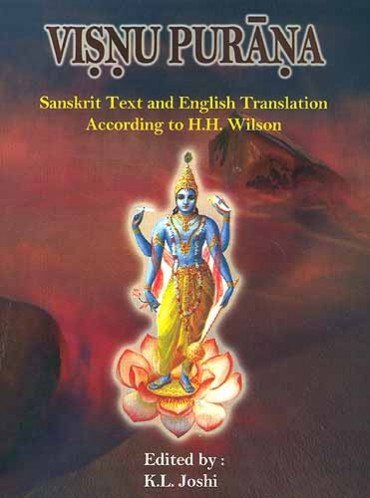The Vishnu Purana
by Horace Hayman Wilson | 1840 | 287,946 words | ISBN-10: 8171102127
The English translation of the Vishnu Purana. This is a primary sacred text of the Vaishnava branch of Hinduism. It is one of the eighteen greater Puranas, a branch of sacred Vedic literature which was first committed to writing during the first millennium of the common era. Like most of the other Puranas, this is a complete narrative from the cr...
The Third Book
The arrangement of the Vedas and other writings considered sacred by the Hindus, being in fact the authorities of their religious rites and belief, which is described in the beginning of the third book, is of much importance to the history of Hindu literature, and of the Hindu religion. The sage Vyāsa is here represented, not as the author, but the arranger or compiler of the Vedas, the Itihāsas, and Purāṇas. His name denotes his character, meaning the ‘arranger’ or ‘distributor;’ and the recurrence of many Vyāsas, many individuals who new modelled the Hindu scriptures, has nothing in it that is improbable, except the fabulous intervals by which their labours are separated. The rearranging, the refashioning, of old materials, is nothing more than the progress of time would be likely to render necessary. The last recognised compilation is that of Kṛṣṇa Dwaipāyaṇa, assisted by Brahmans, who were already conversant with the subjects respectively assigned to them. They were the members of a college or school, supposed by the Hindus to have flourished in a period more remote, no doubt, than the truth, but not at all unlikely to have been instituted at some time prior to the accounts of India which we owe to Greek writers, and in which we see enough of the system to justify our inferring that it was then entire. That there have been other Vyāsas and other schools since that date, that Brahmans unknown to fame have remodelled some of the Hindu scriptures, and especially the Purāṇas, cannot reasonably be contested, after dispassionately weighing the strong internal evidence which all of them afford of the intermixture of unauthorized and comparatively modern ingredients. But the same internal testimony furnishes proof equally decisive of the anterior existence of ancient materials; and it is therefore as idle as it is irrational to dispute the antiquity or authenticity of the greater portion of the contents of the Purāṇas, in the face of abundant positive and circumstantial evidence of the prevalence of the doctrines which they teach, the currency of the legends which they narrate, and the integrity of the institutions which they describe, at least three centuries before the Christian era. But the origin and developement of their doctrines, traditions, and institutions, were not the work of a day; and the testimony that establishes their existence three centuries before Christianity, carries it back to a much more remote antiquity, to an antiquity that is probably not surpassed by any of the prevailing fictions, institutions, or belief, of the ancient world.
The remainder of the third book describes the leading institutions of the Hindus, the duties of castes, the obligations of different stages of life, and the celebration of obsequial rites, in a short but primitive strain, and in harmony with the laws of Manu. It is a distinguishing feature of the Viṣṇu Purāṇa, and it is characteristic of its being the work of an earlier period than most of the Purāṇas, that it enjoins no sectarial or other acts of supererogation; no Vratas, occasional self-imposed observances; no holidays, no birthdays of Kṛṣṇa, no nights dedicated to Lakṣmī; no sacrifices nor modes of worship other than those conformable to the ritual of the Vedas. It contains no Māhātmyas, or golden legends, even of the temples in which Viṣṇu is adored.
